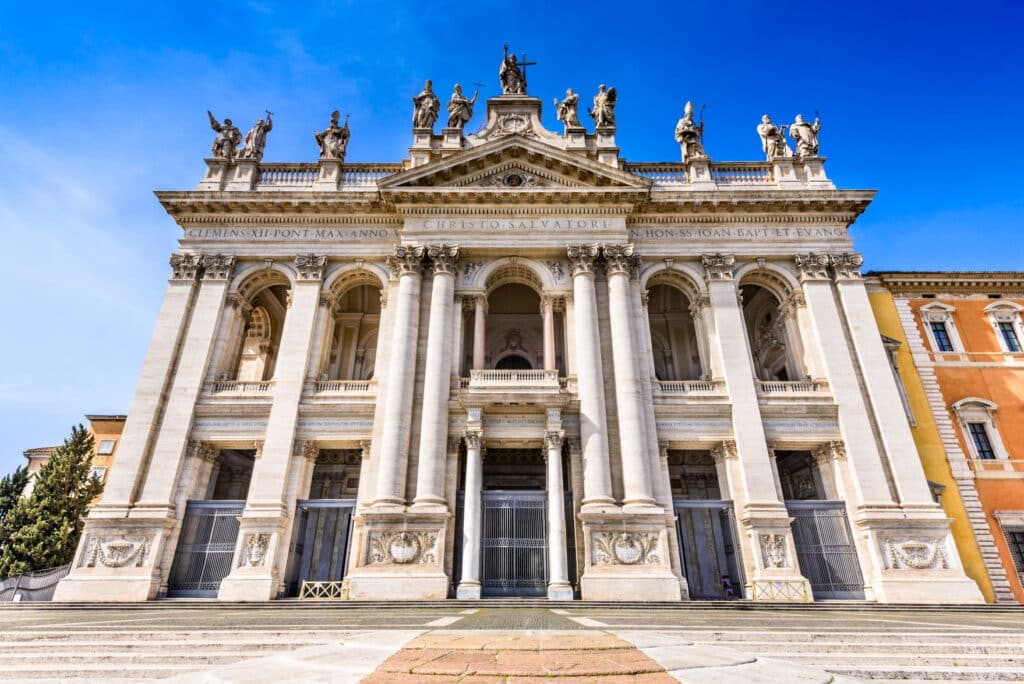
Entrance to The Archbasilica of St. John in Lateran is essentially free. However, the entrance to the Cloister and the Lateran Treasury Museum, which are part of the Archbasilica of St. John in Lateran, are chargeable and the entrance fee is 10€ for the year 2025.
The Archbasilica of Saint John Lateran, officially known as the Cathedral of the Most Holy Savior and of Saints John the Baptist and the Evangelist in the Lateran, is one of the most significant and historic churches in Rome, Italy. As the cathedral of the Bishop of Rome, who is also the Pope, it holds the title of “Mother and Head of all the Churches of the City and the World.” Despite the prominent position of Saint Peter’s Basilica in Vatican City, Saint John Lateran is actually the highest-ranking of Rome’s four major basilicas and is considered the ecumenical mother church of the Catholic faithful.
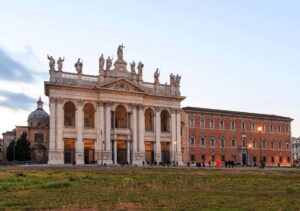
Archbasilica of St. John in Lateran
Constructed under the auspices of Emperor Constantine I in the 4th century, the basilica has undergone numerous reconstructions and restorations over the centuries, reflecting various architectural styles, including early Christian, Baroque, and Neoclassical. The current façade, designed by Alessandro Galilei, was completed in 1735 and features colossal statues of Christ, John the Baptist, John the Evangelist, and the twelve apostles. The basilica’s interior, predominantly Baroque, boasts impressive art and architectural elements, such as the nave’s colossal marble statues depicting the twelve apostles and the stunning Cosmatesque floor.
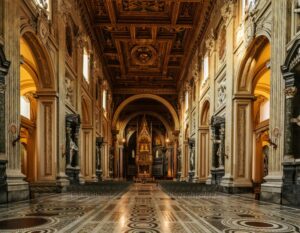
Interior – Archbasilica of St. John in Lateran
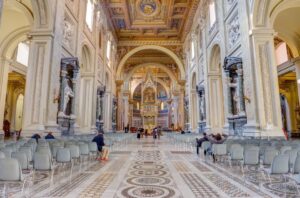
Interior – Archbasilica of St. John in Lateran
One of the key features of the basilica is the Lateran Baptistery, also known as the Baptistery of Saint John. Built by Emperor Constantine I and significantly renovated in later centuries, it is one of the oldest and most important baptismal sites in Christendom. The baptistery’s octagonal structure has a central font, which was once used for full-immersion baptism, surrounded by eight porphyry columns supporting a circular architrave.
Another noteworthy element of the complex is the Holy Stairs or Scala Sancta, which are believed to be the same steps that Jesus climbed during his trial before Pontius Pilate. The stairs were brought to Rome by Saint Helena, the mother of Emperor Constantine I, in the 4th century. Pilgrims traditionally ascend these 28 marble steps on their knees, as a sign of devotion and penance.
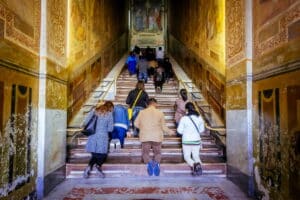
People pray at Holy Stairs, Scala Santa, in Rome, Italy. Photo Credit: CRT – Lateran Basilica
The Archbasilica of Saint John Lateran is also home to the Papal or Lateran Palace, which was the official residence of the Pope until the 14th century when the papal seat was moved to Avignon. Today, the palace serves as the seat of the Vicariate of Rome and houses the offices of the Roman Catholic Diocese of Rome and its bishop, the Pope.
With its rich history, architectural grandeur, and deep significance to the Catholic Church, the Archbasilica of Saint John Lateran remains an important destination for both religious pilgrims and tourists interested in the cultural and historical heritage of Rome.
Continuing the exploration of the Archbasilica of Saint John Lateran, there are several more notable features that contribute to its historic and religious importance.
One of the basilica’s most significant relics is the wooden altar, which is said to have been used by Saint Peter himself. This altar is encased in a magnificent ciborium or baldachin, designed by the architect and sculptor Giovanni di Stefano in the 14th century. The ciborium is supported by four porphyry columns, and its intricate Cosmatesque decorations and gilded bronze canopy make it a visually striking element of the basilica’s interior.
The apse of the basilica is adorned with a grandiose 13th-century mosaic, designed by the artist Jacopo Torriti. This stunning work of art portrays Christ as the Savior of the World, surrounded by saints and angels, while below, Pope Nicholas IV is shown presenting the church to the Virgin Mary. The mosaic not only serves as a beautiful backdrop for the altar but also symbolizes the deep connection between the Church and the papacy.
Another remarkable feature of Saint John Lateran is the Triclinium Leoninum, the remains of the ancient papal dining hall dating back to the 9th century. While only a small portion of the original structure remains, the apse mosaic still stands, illustrating Christ blessing a banquet attended by the apostles. This historical relic is an important reminder of the basilica’s past as the heart of the papal residence and the center of ecclesiastical life in Rome.
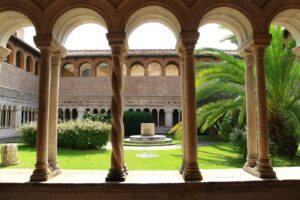
Cloister – Archbasilica of St. John in Lateran
Adjacent to the Archbasilica of Saint John Lateran is the beautiful 16th-century cloister, a serene and tranquil space enclosed by arcades with twisted double columns. The Cosmatesque-style decoration, featuring geometric patterns of inlaid marble, can be seen on the floor and the fountain in the center of the garden. This peaceful oasis is a stark contrast to the bustling city outside and offers visitors a chance to reflect on the spiritual significance of the site.

